Day 2 of a 3 day long weekend of tours today. It was a lovely warm and sunny start to the day, but we knew that rain was forecast for the afternoon, so we had to make the most of it. We made our way east along the coast to Cley.
North Scrape has been the best scrape for waders in recent days on the reserve. It can be difficult viewing here in the heat of the day, looking into the sun, so we decided to go round here first. As we got out of the car in the car park, a Wheatear was on the top of the shingle ridge behind us. A nice start to the day.
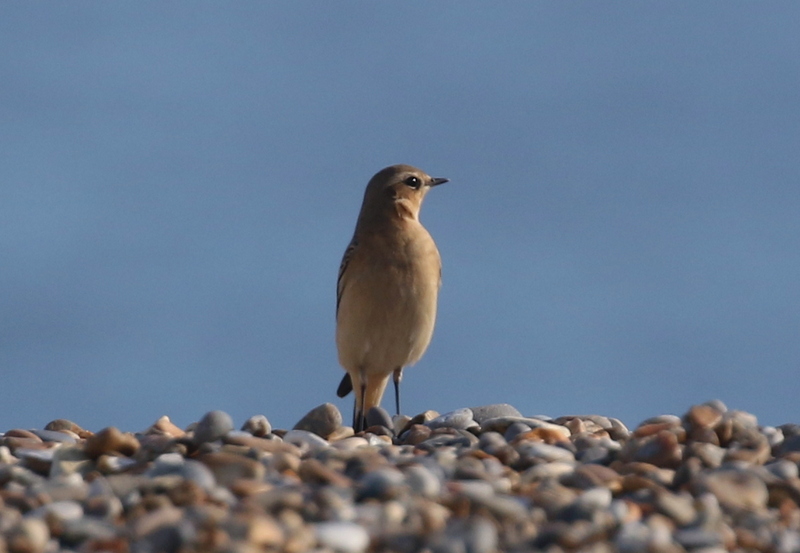 Wheatear – on the shingle in the car park when we arrived
Wheatear – on the shingle in the car park when we arrived
Before we had finished unloading the car, we were called over by some people a few cars further along. They had found a freshly dead Dunlin on the shingle nearby and were not sure what it was. It was amazing to look at up close – a juvenile, with black streaks on its belly. It was missing a wing, but otherwise appeared undamaged. An odd injury, it was unclear whether it was killed by the impact from a raptor or perhaps yet another victim of the lethal high tension fence which has inexplicably been put up around that part of the reserve.
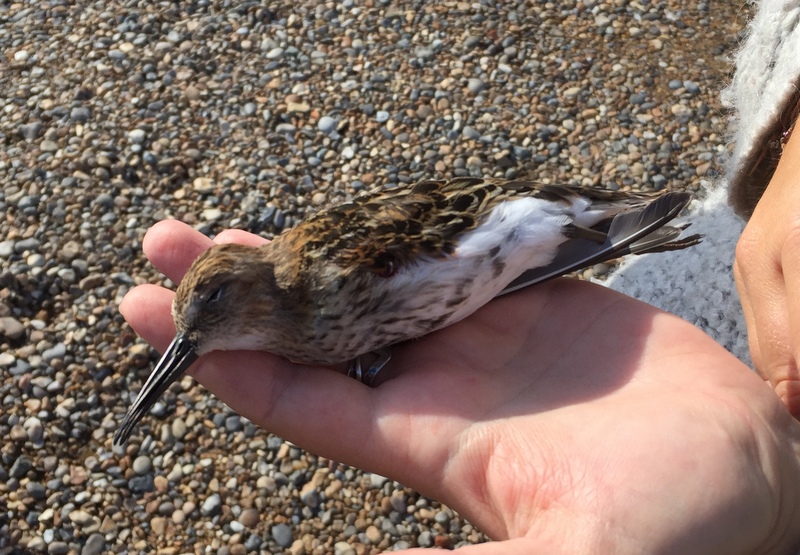 Dunlin – this juvenile was found freshly dead on the shingle
Dunlin – this juvenile was found freshly dead on the shingle
As we walked out beside the beach to North Scrape, a Sandwich Tern called and flew past close inshore. A large Grey Seal surfaced just off the beach, before diving again. When we arrived at North Scrape, it appeared strangely quiet compared to recent days. We were informed that a Hobby, 2 Marsh Harriers and a Common Buzzard had flown over, flushing all the waders – we saw one each of the latter two species while we were there.
Many of the waders had flown off, but the Curlew Sandpipers at least had apparently just flown round the corner out of view. We decided to sit for a while and see what reappeared. A couple of Ringed Plovers were well camouflaged on the nearest, sandy island. Then a single Knot appeared in the water nearby, giving a great view through the scope. A Greenshank was sleeping nearby, along with a couple of Dunlin. Two Green Sandpipers flew in but dropped out of view in the reeds, before flying back off again.
The two Curlew Sandpipers started to walk out into view. They were hard to see well at first, looking through the tops of the reeds in the foreground, and we had to put the scope on the top of the bank. Fortunately, after a while, they flew out and landed in full view at the front of the scrape, where we could see them much better. They were both juveniles, smart birds with scaly backs, a well-marked supercilium and a peachy wash across the breast.
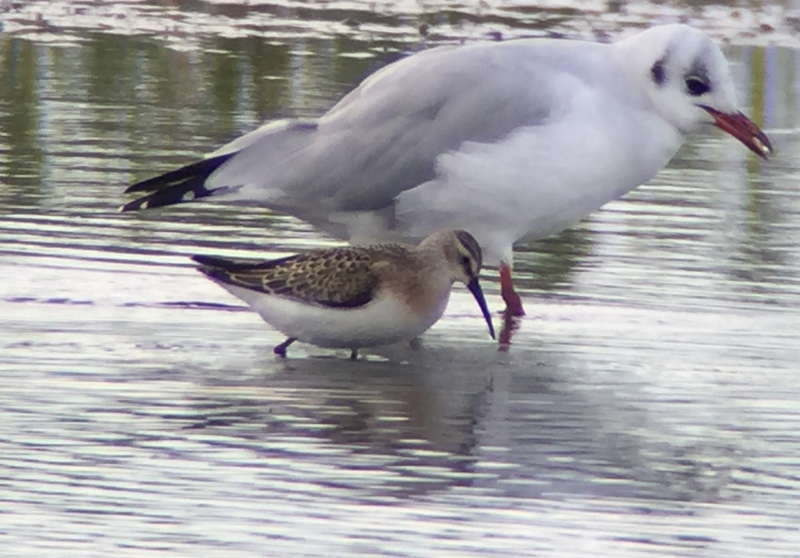 Curlew Sandpiper – a juvenile, dwarfed by a Black-headed Gull
Curlew Sandpiper – a juvenile, dwarfed by a Black-headed Gull
There was no sign of any Wood Sandpipers though, which was the species we had particularly hoped to see here. When the news came through that they had relocated themselves to Pat’s Pool, we decided to drive round and have a look at the other side of the reserve. On the way back to the car park, we stopped to admire a couple of Common Darters which were basking in the morning sunshine in the shelter of the path.
 Common Darter – enjoying the morning sun
Common Darter – enjoying the morning sun
A couple of Wheatears were chasing each other round the now dried-up pool by the fence. They wouldn’t stop still at first, but finally one landed on the top of a dried poppy plant where we could all have a good look at it through the scope. When it eventually took off again, we had a great view of its white rump as it flew past us.
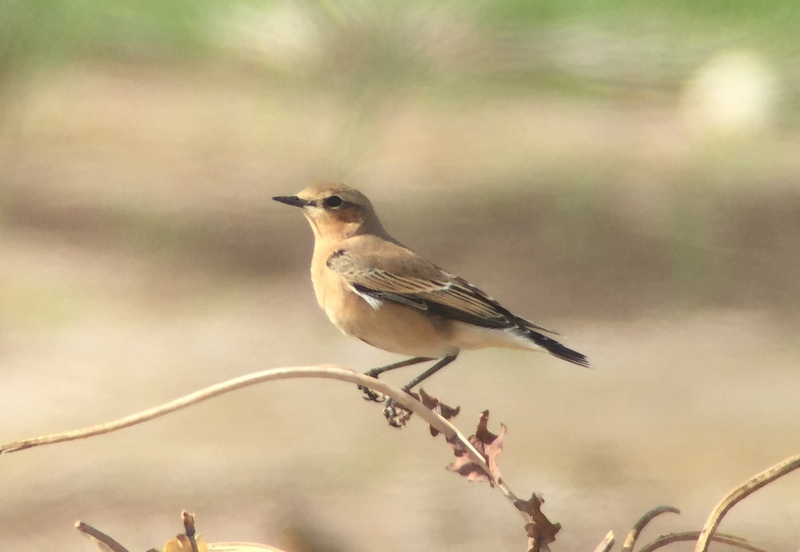 Wheatear – two were chasing round by the beach
Wheatear – two were chasing round by the beach
We went round to Bishop Hide first. As we walked along the path, we caught a brief sight of a Hobby hawking for insects low over the reedbed. The hide itself was surprisingly full of people. There was a good flock of Black-tailed Godwits sleeping out on the mud and a selection of Ruff scattered around the scrape. The latter included both brown and buff juveniles and grey and white winter adults. One person thought they had found the two Wood Sandpipers at one point but all we could see when they pointed out where they were looking were a couple of Ruff in the edge of the reeds. We decided to head over to the other hides instead.
As we walked along the boardwalk, our attention was drawn by a small orangey-buff bird on the fence along the edge of the reeds. It was a Whinchat. It kept dropping down into the grass before returning to the fence, where it sat very obligingly for us to admire it.
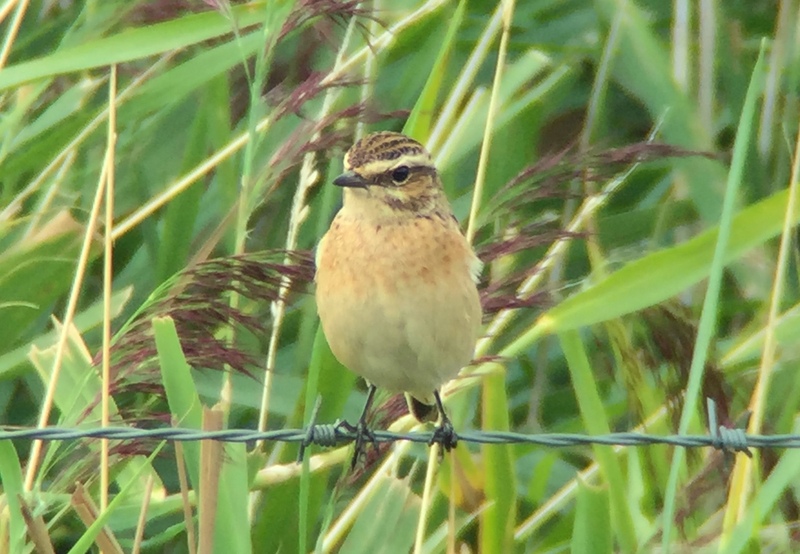 Whinchat – on the fence by the boardwalk out to the hides
Whinchat – on the fence by the boardwalk out to the hides
Looking out across the other side of Pat’s Pool from Teal Hide, there was still no sign of the Wood Sandpipers – they had probably flown back to North Scrape! We did have nice close views of three juvenile Black-tailed Godwits feeding just in front of the hide, which were nice to see. A flock of Golden Plover landed on the main island and started to bathe in the shallow water, most still sporting the remnants of their summer black bellies.
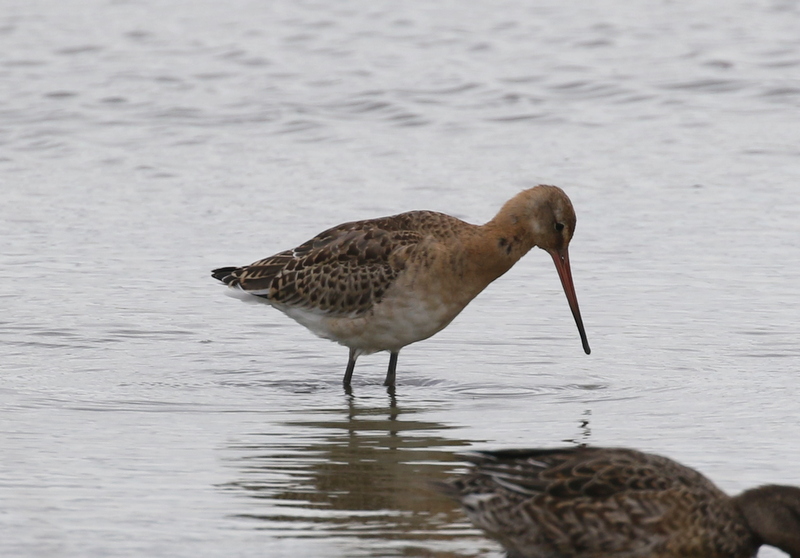 Black-tailed Godwit – a juvenile of the Icelandic race
Black-tailed Godwit – a juvenile of the Icelandic race
Even better, a couple of Reed Warblers appeared in the cut reeds right outside the hide. One in particular was hopping around in a patch of dead vegetation very close to us, giving us great views.
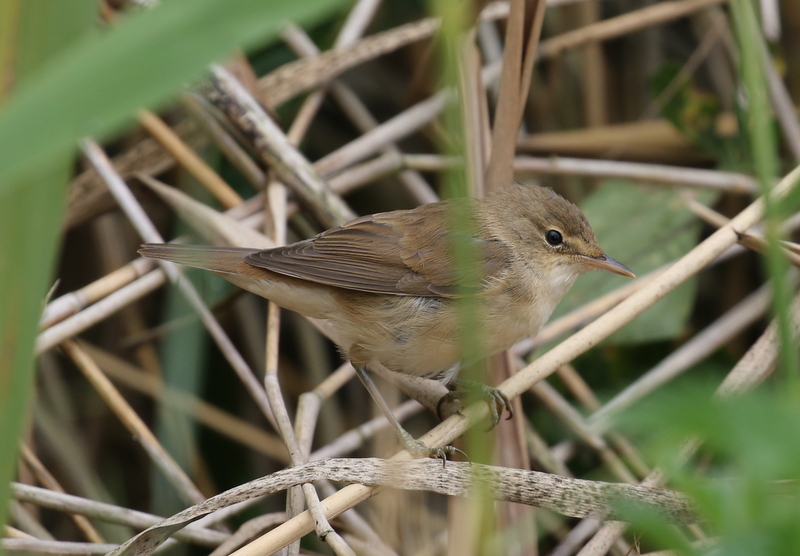 Reed Warbler – feeding in the cut reeds just outside the hide
Reed Warbler – feeding in the cut reeds just outside the hide
From Dauke’s Hide, a quick look at Simmond’s Scrape did not produce much we had not already seen, apart from a sleeping Yellow-legged Gull. This scrape is apparently scheduled to be reworked this month and has been kept drier than normal accordingly over the last couple of weeks, which may explain why it has been quieter on here. So we headed back to the visitor centre for lunch. It had clouded over, but there were still only a few spots of rain for now.
The pool beside Iron Road has been looking great for waders over the last few days, so it was no great surprise to learn that a Pectoral Sandpiper had been found there. After lunch, we made our way over there to try to see it. It had disappeared into the grass when we arrived, but while we waited for it to reappear, there were several other good birds to see. A Yellow Wagtail flew in and landed at the feet of one of the cows nearby, showing off its very bright yellow undertail.
Best of all, we finally caught up with a Wood Sandpiper – getting really good views of one feeding on one of the muddy pools here, admiring its spangled upperparts and well-marked pale supercilium. A Green Sandpiper flew in to the same pool, much darker above, less obviously spotted. There was even a Little Stint on here too, which eventually came out onto a more open patch of mud where we could get a proper look at it.
The Pectoral Sandpiper frustrated us for a while, making a brief appearance out of the grass but quickly being flushed by a passing calf and disappearing back into cover. Then finally, it worked its way to the edge of one of the grassy islands where we could see it, before walking out across in the open. We could see its brown streaked breast, ending in a well-defined curve, the pectoral band.
 Pectoral Sandpiper – eventually showed well
Pectoral Sandpiper – eventually showed well
A sharp ‘tchooeet’ call alerted us to an approaching Spotted Redshank. It flew in from the east and over our heads, dropping down over the back of the pool towards Babcock Hide. As it was now starting to drizzle a little, we thought it would be a good place to sit for a while, so walked round to the hide.
As we opened the shutters, we could see a Common Sandpiper feeding quietly on the mud in front of the hide, out to the left. It slowly worked its way across in front of us, moving very furtively and bobbing its tail as it went. We could see the tell-tale white spur extending up between the darker breast and the wings.
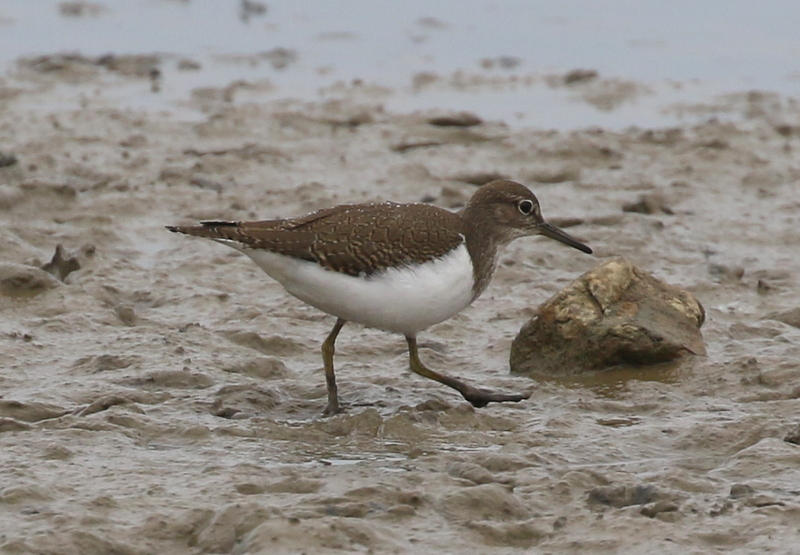 Common Sandpiper – on the mud in front of Babcock Hide
Common Sandpiper – on the mud in front of Babcock Hide
Then the Spotted Redshank appeared from behind one the islands. It was feeding vigorously in the distinctive way Spotted Redshanks do, head down, sweeping its bill quickly from side to side through the water. It was a dusky grey juvenile, and when it raised its head from time to time we could see the distinctive long, needle sharp bill, with a tiny downward kink near the end.
Even better, the Spotted Redshank progressively worked its way towards the hide and was then joined by a couple of Common Redshanks. It was great to see the two species side by side for comparison. One of the Common Redshanks even tried to copy the Spotted Redshank’s feeding action at one point, following round behind it, before giving up and resuming a more delicate probing in the mud.
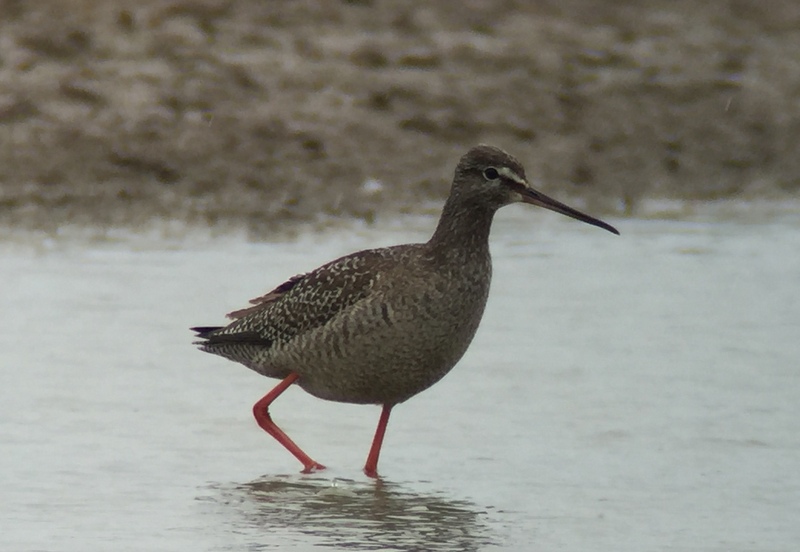 Spotted Redshank – a dusky grey juvenile
Spotted Redshank – a dusky grey juvenile
There were other things to see here too, as we sat out a passing heavier shower. There was no shortage of Snipe, but three flew in and landed on the mud in front of the hide. A Lapwing was feeding on the edge of the vegetation just below us too, looking very colourful despite the gloomy conditions now.
 Lapwing – still looking very exotic in the rain
Lapwing – still looking very exotic in the rain
A family of Little Grebes were diving out in the water and one of the adults even came out onto one of the islands at one point – most ungainly birds on dry land! A couple of Marsh Harriers flew in from the east, one duller male doing a very close fly by past the hide. We heard Bearded Tits calling from the reeds, but the one which appeared briefly in the tops unfortunately didn’t hang around long enough for everyone to get onto it. The Cormorants gave up trying to dry their wings once the rain started.
When the rain eased again, we got news that a Redstart had been seen the other side of Salthouse at Gramborough Hill, so we made our way over to try to see it. There were a few people working their way round the bushes when we arrived, and we got a very brief glimpse of the Redstart as it dived into cover. We had better views of a smart male Stonechat, which more helpfully perched on the top of the bushes.
Unfortunately, we were on the wrong side of the brambles and the Redstart flew off again as we tried to work our way round. It disappeared round the hill and couldn’t immediately be refound. At that point it started to rain again. It was already getting on and we had been much luckier with the weather this afternoon than we had expected, so we decided to call it a day. Looking at all the things we had seen, what a great day it had been!
















